Privy Council of Japan
This article needs additional citations for verification. (March 2020) |

The Privy Council of Japan (枢密院, Sūmitsu-in) was an advisory council to the Emperor of Japan that operated from 1888 to 1947. It was largely used to limit the power of the Imperial Diet.[1][2]
Functions
[edit]Modeled in part upon the British Privy Council, this body advised the Japanese Empire on matters including, but not limited to:
- Proposed amendments to the Constitution of the Empire of Japan
- Proposed amendments to the 1889 Imperial Household Law
- Matters of constitutional interpretation, proposed laws, and ordinances
- Proclamations of martial law or declaration of war
- Treaties and other international agreements
- Matters concerning the succession to the throne
- Declarations of a regency under the Imperial Household Law;
- Matters submitted by the Emperor directly

The Privy Council had both judicial functions and certain executive functions. However, the council had no power to initiate legislation.
Establishment
[edit]To oversee new governmental developments, in 1871, three councils were created - the Council of the Left, Centre, and Right, who would be collectively known as the Council of the Elders (genrō in). The Elders oversaw the writing of the Meiji Constitution, and would become councilors in the Privy Council.[3]
The Privy Council of Japan was established by an imperial ordinance of Emperor Meiji dated 28 April 1888, under the presidency of Itō Hirobumi, to deliberate on the draft constitution.[4] The new constitution, which the emperor promulgated on 11 February 1889, briefly mentioned the Privy Council in Chapter 4, Article 56: "The Privy Councilors shall, in accordance with the provisions for the organization of the Privy Council, deliberate upon important matters of State when they have been consulted by the Emperor."
The Privy Council consisted of a chairman, a vice chairman (non-voting), twelve (later expanded to twenty-four) councilors, a chief secretary, and three additional secretaries. All privy councilors including the president and the vice president were appointed by the Emperor for life, on the advice of the Prime Minister and the cabinet. In addition to the twenty-four voting privy counselors, the Prime Minister and the other ministers of state were ex officio members of the council. The princes of the imperial household (both the shinnōke and the ōke ) over the age of majority were permitted to attend meetings of the Privy Council and could participate in its proceedings. [citation needed] The president was the authority as he called and controlled meetings inside of the council.[citation needed] The Council met in secret at the Tokyo Imperial Palace, with the Emperor in attendance on important occasions. The Council was empowered to deliberate on any matters upon which the Emperor desired an opinion.[citation needed]
Assessment
[edit]Theoretically, the Privy Council's legal power was extensive, but, like many other aspects of Meiji-era politics, the effective power of the Privy Council was largely based upon the genrō and other oligarchs. Masao Maruyama described the Council as an "irrational arrangement prevailed in which decisions depended on fortuitous human relations, psychological coercion by the Elder Statesmen [genro] and other ‘officials close to the Throne,’ shifts in the relative strength of cliques, deals among wire-pullers and bosses, assignation-house politics, and so forth."[5]

During its early years, many members of the Privy Council were simultaneously members of the elected government; however in its later years, the Privy Council essentially replaced the genrō and the Genrōin as a very conservative “old boys” club, often at odds with the party-dominated elected government.[6] After the Privy Council unsuccessfully challenged the government by attempting to reject several government decisions, and by attempting to assert itself on certain foreign policy issues, it was demonstrated that in actuality the balance of power was with the elected government. [citation needed] The Privy Council was thenceforth largely ignored, and was not consulted on major policy matters, including the Attack on Pearl Harbor. [citation needed]
The Privy Council was abolished with the enforcement of the current postwar Constitution of Japan on 3 May 1947.
Leadership
[edit]Presidents
[edit]Fifteen people served as the President of the Privy Council of Japan.
| Portrait | Name | Term start | Term end |
|---|---|---|---|
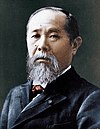
|
Count Itō Hirobumi (1841–1909) |
30 April 1888 | 30 October 1889 |

|
Count Ōki Takatō (1832–1899) |
24 December 1889 | 1 June 1891 |

|
Count Itō Hirobumi (1841–1909) |
1 June 1891 | 8 August 1892 |

|
Count Ōki Takatō (1832–1899) |
8 August 1892 | 11 March 1893 |
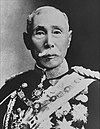
|
Count Yamagata Aritomo (1838–1922) |
11 March 1893 | 12 December 1893 |

|
Count Kuroda Kiyotaka (1840–1900) |
17 March 1894 | 25 August 1900 |
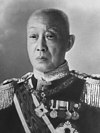
|
Marquis Saionji Kinmochi (1849–1940) |
27 August 1900 | 13 July 1903 |

|
Marquis Itō Hirobumi (1841–1909) |
13 July 1903 | 21 December 1905 |

|
Marquis Yamagata Aritomo (1838–1922) |
21 December 1905 | 14 June 1909 |

|
Prince Itō Hirobumi (1841–1909) |
14 June 1909 | 26 October 1909 |

|
Prince Yamagata Aritomo (1838–1922) |
26 October 1909 | 1 February 1922 |

|
Viscount Kiyoura Keigo (1850–1942) |
8 February 1922 | 7 January 1924 |

|
Viscount Hamao Arata (1849–1925) |
13 January 1924 | 25 September 1925 |
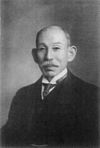
|
Baron Hozumi Nobushige (1855–1926) |
1 October 1925 | 8 April 1926 |

|
Baron Kuratomi Yūzaburō (1853–1948) |
12 April 1926 | 3 May 1934 |

|
Baron Ichiki Kitokurō (1867–1944) |
3 May 1934 | 13 March 1936 |

|
Baron Kiichirō Hiranuma (1867–1952) |
13 March 1936 | 5 January 1939 |

|
Prince Fumimaro Konoe (1891–1945) |
5 January 1939 | 24 June 1940 |

|
Hara Yoshimichi (1867–1944) |
24 June 1940 | 7 August 1944 |

|
Baron Suzuki Kantarō (1868–1948) |
7 August 1944 | 7 June 1945 |

|
Baron Kiichirō Hiranuma (1867–1952) |
9 April 1945 | 3 December 1945 |

|
Baron Suzuki Kantarō (1868–1948) |
3 December 1945 | 13 June 1946 |

|
Shimizu Tōru (1868–1947) |
13 June 1946 | 26 September 1946 |
Vice presidents
[edit]| Portrait | Name | Term start | Term end |
|---|---|---|---|

|
Count Terashima Munenori (1832–1893) |
10 May 1888 | 10 September 1891 |

|
Count Soejima Taneomi (1828–1905) |
10 September 1891 | 11 March 1892 |
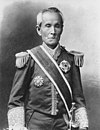
|
Count Higashikuze Michitomi (1834–1912) |
17 March 1892 | 4 January 1912 |

|
Count Yoshikawa Akimasa (1842–1920) |
9 January 1912 | 20 March 1917 |

|
Viscount Kiyoura Keigo (1850–1942) |
20 March 1917 | 8 February 1922 |

|
Viscount Hamao Arata (1849–1925) |
15 February 1922 | 13 January 1924 |

|
Ichiki Kitokurō (1867–1944) |
14 January 1924 | 30 March 1925 |

|
Baron Hozumi Nobushige (1855–1926) |
30 March 1925 | 1 October 1925 |

|
Okano Keijirō (1865–1925) |
1 October 1925 | 23 December 1925 |

|
Baron Kuratomi Yuzaburo (1853–1948) |
28 December 1925 | 12 April 1926 |

|
Baron Kiichirō Hiranuma (1867–1952) |
12 April 1926 | 13 March 1936 |

|
Arai Kentarō (1867–1952) |
13 March 1936 | 29 January 1938 |

|
Hara Yoshimichi (1867–1944) |
3 February 1938 | 24 June 1940 |

|
Baron Suzuki Kantarō (1868–1948) |
24 June 1940 | 10 August 1944 |

|
Shimizu Tōru (1868–1947) |
10 August 1944 | 13 June 1946 |

|
Shigenosuke Ushio (1881–1955) |
13 June 1946 | 2 May 1947 |
See also
[edit]Notes
[edit]- ^ Colegrove, Kenneth (1931). "The Japanese Privy Council". American Political Science Review. 25 (3): 589–614. doi:10.2307/1946968. ISSN 0003-0554. JSTOR 1946968. S2CID 143998371.
- ^ Colegrove, Kenneth (1931). "The Japanese Privy Council". American Political Science Review. 25 (4): 881–905. doi:10.2307/1946610. ISSN 0003-0554. JSTOR 1946610. S2CID 251095531.
- ^ von Staden, Pete (2008). Business-Government Relations in Prewar Japan. Routledge. p. 35.
- ^ Beasley, The Rise of Modern Japan. pp. 68
- ^ Maruyama, Masao (1963). Thought and Behaviour in Modern Japanese Politics. Oxford University Press. p. 232.
- ^ Gordon, A History of Modern Japan, pp.92
References
[edit]- Beasley, William G. (2000). The Rise of Modern Japan. New York: Palgrave Macmillan. ISBN 0-312-23373-6.
- Colgrove, Kenneth W. (1931). The Japanese Privy Council. ASIN: B00086SR24.
- Gordon, Andrew (2003). A Modern History of Japan: From Tokugawa Times to the Present. Oxford: Oxford University Press. ISBN 0-19-511061-7.
- Jansen, Marius B. (2000). The Making of Modern Japan. Cambridge: Harvard University Press. ISBN 9780674003347. ISBN 9780674003347; OCLC 44090600
- Takenobu, Yoshitaro (1928). The Japan Yearbook; Complete Cyclopaedia of General Information and Statistics on Japan and Japanese Territories. Tokyo: The Japan Year Book Office.; OCLC 145151778
